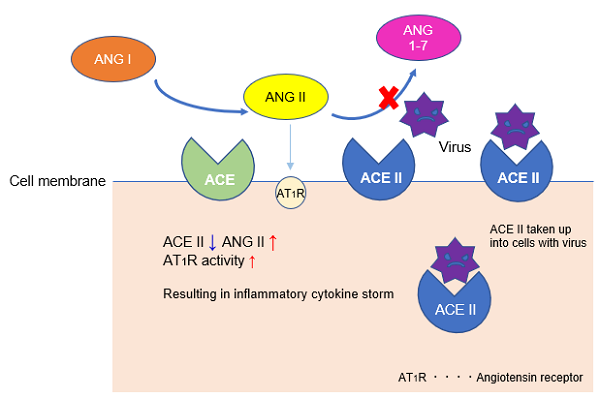ACE Kit-WST is expected to be an advantageous tool to support the discovery of ACE inhibitors effective at suppressing inflammation after SARS-CoV-2 infection.
Angiotensin-converting enzyme (ACE) produces angiotensin II (Ang II), a vasoconstrictor, from the C-terminus of angiotensin I (Ang I), which has almost no biological activity. ACE and Ang II activity is countered by ACE2, which functions to cleave inflammatory Ang II into non-inflammatory peptide Ang 1-7.
During SARS-CoV-2 infection, angiotensin-converting enzyme 2 (ACE2) from the cell membrane is taken up into cells along with the virus, decreasing ACE2 activity on the cell membrane. As a result, angiotensin II (Ang II), which had been counteracted by ACE2, becomes uninhibited, beginning a cascade towards an inflammatory cytokine storm that has been suggested to promote lung damage.
Thus, Ang-II mediated cytokine storm is considered to be an important mechanism of severe COVID-19. Therefore, ACE inhibitors, which suppress the Ang II system, are currently expected to reduce the risk of severe Covid-19 symptoms brought on by inflammation, such as acute respiratory distress.

References
1. Hoffmann M, Kleine-Weber H, Schroeder S, et al., “Sars-cov-2 cell entry depends on ace2 and tmprss2 and is blocked by a clinically proven protease inhibitor”, Cell, 2020, 181, 271-280 e278.
2. Imai Y, Kuba K, Rao S, et al., “Angiotensin-converting enzyme 2 protects from severe acute lung failure” Nature, 2005, 436, 112-116.
3. Zou Z, Yan Y, Shu Y, et al., “Angiotensin-converting enzyme 2 protects from lethal avian influenza a h5n1 infections”, Nat Commun., 2014, 5, 3594.
4. Gu H, Xie Z, Li T, et al., “Angiotensin-converting enzyme 2 inhibits lung injury induced by respiratory syncytial virus”, Sci Rep., 2016, 6, 19840.




